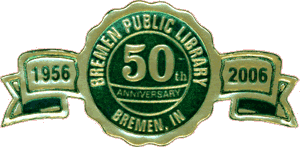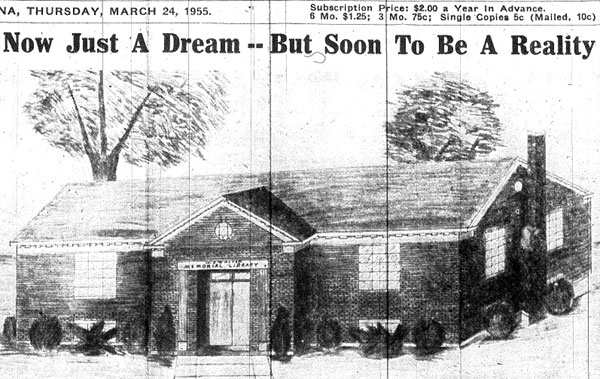

This article was published in the August 24, 2006 issue of The Bremen Enquirer and is reprinted here with their permission.
This story marks the second installment in a series highlighting the history of the W.E. Walter Memorial Library, which celebrates its 50th anniversary this month.
By Amy Wenger
Enquirer Correspondent
BREMEN — It was more than a century ago that a decree was proffered to all Hoosiers granting them the opportunity to make use of free public libraries. The influence of that edict took some time to become a reality for the community of Bremen, but eventually, the town welcomed its first library, opened in 1925 at the Town Hall.
While the library proved quite successful in its fairly makeshift capacity, it would eventually be realized that the arrangement was merely suited to be temporary. As early as the 1930s, the townspeople were discussing ways to remedy the predicament, but it would be another several years before a group of folks would align themselves in taking a more proactive stance.
A pristinely preserved, meticulously scribed journal reveals details about how the foundation was established to raise interest in a public library. The journal, now housed in the archives of the current Bremen Public Library, dates back to 1953 and presents intriguing glimpses into the motivation and inspiration that drove the volunteer brigade. It was in June of that same year that the Library Planning Committee was formed, and a large dinner meeting was held at the American Legion Hall to officially launch the endeavor. Sponsored by the Kiwanis Club, the evening was a resounding success, with more than 20 organizations sending representatives, plus scores of individuals on hand as well. Donations were noted, with the local Christian Science Church giving nearly $1,000, with a number of clubs and other parties providing additional funds.
One announcement in particular captivated the audience to the point of rousing applause — that of an anonymous offering of $15,000 from someone who was noted in the meeting minutes as a "public spirited citizen."
Nominations were accepted from the floor, and before the evening ended, the following individuals had been chosen to become part of the newly formed committee: Mrs. James Crittenden, Mrs. John Baird, Mrs. Fred Schlemmer, Mrs. Clyde Ellis, Henry Kiefer, Jr., Jack Stanifer, Edward Berg, Dr. H.D. Furst, and Ernest Annis. The group wasted little time getting right to the business at hand; their first official meeting took place at the close of the dinner event.
Among the matters discussed in that inaugural session were how to go about utilizing tax dollars to support the library, the appropriate number of books needed to begin an inventory, and how to go about securing a centrally located site allowing for easy access for both the citizens of Bremen, and for those residing in German Township.
Over the course of the months that followed, the committee would convene sporadically to address pertinent issues, each gathering leading the membership closer to the realization of a master plan and the announcement of a fund raising mission. Within just weeks of that first summer meeting, Dr. Furst, the committee chairman, presented to his fellow volunteers a deed for land situated on what seemed to be an ideal spot to contemplate for a building project — one block west and two short blocks north from the center square of town, along the Jackson Street corridor.
The transaction of sale would commence. The lot was purchased for a sum of $3,000.
It was a rather fateful turn of events, proving to be providential in more ways than one. The property almost exactly met with the specifications the committee had been seeking for a central site.
It was also the location on which was once the boyhood home of Mr. William E. Walter.
And it was his wife, Mrs. W.E. Walter, who was discovered to be the mystery donor of the exceptionally generous $15,000 donation. She knew of no better way to honor the life of her husband than by having a library erected on the land where he spent his childhood years.
For Mrs. Walter, this gesture of goodwill also carried a measure of spiritual significance as well. For a number of years, there was a house situated on the site adjacent to the present library, which had served as a gathering place for the local assemblage of the Christian Science Church, of which the Walters were actively involved.
Developments moved along as the months ambled by. As more financial gifts were tallied, there were countless others who offered their time and talents in fitting ways. Some gave of building materials, others promised free labor, and still others asked to share furniture and office supplies. Meanwhile, the committee members busied themselves studying various topics relevant to the prospective project, traveling throughout the state and visiting libraries in like communities. It was decided that in terms of a model library to emulate in the building phase, Bourbon's facility most closely resembled what the committee was striving for.
Finally, in March of 1955, enough of the preliminary details had been finalized that the movement to raise funds could get underway. At a spring meeting of the Kiwanis Club, the committee provided a presentation that noted the hiring of I.O. Pfeiffer as architect, and the special monetary gift given by Mrs. W.E. Walter. Pfeiffer had given an early estimate for the project in the vicinity of $25,000. However, the Walter family donation reduced the amount of monies needing to be garnered by just under half, after the cost of purchasing land had been deducted.

In the March 24, 1955 edition of The Bremen Enquirer, a sketch graced the front page of the paper, illustrating what was anticipated to be the finished product of the library project. The single story brick structure would measure 50 feet by 34 feet, with a full basement below the main floor. Tentative plans allowed for a kitchen, an assembly hall, and a recreation area in the basement. The main floor would house the media collection, with the books and other items all designed around the librarian's desk.
Especially fitting was the fact that the fund drive began in full force during Indiana Library Week. "People are being reminded of the priceless function performed by the public library in education in the state," quoted an editorial from the day. "The publicity afforded by Library Week will call attention again to the fine service every citizen can render to the common welfare by helping the campaign for the building fund."
Just days into the campaign, a sprawling front page feature drafted by Anita Morland, wife of Bremen Public Schools superintendent John Morland, captured the attention of the town. Entitled "The Library Speaks," Morland authored a poetic first-person narrative, written from the perspective of the library as an embodiment. In the essay, the library "speaks" of its positive influence to the nation's young people, then eloquently sums up the sentiment with the question "Can you show me any human force more versatile than mine?"
Tremendously moved by the powerful composition, Mrs. Walter submitted a copy of the story to the "Christian Science Monitor", which in turn reprinted it as a testimony to the support of all American libraries. The article was reproduced in several additional publications, reaching a nationwide audience. In an excerpt from a letter that Mrs. Walter also included with the submission, she praised the townspeople of Bremen for their "demonstration of loyalty, co-operation, and team work."
Mrs. Walter also observed how the writings were so compelling, that once the story was published in The Bremen Enquirer, it created a rush of donations that pushed the total amount of funds raised to just above the overall amount needed. And so by May of 1955, the time had already arrived for the library committee to select contractors, with the work slated to begin shortly thereafter.
A little over one year later, civic leaders, volunteers, and the general public convened at the corner of Bike and Jackson streets to herald the coming of the new town library. It was a Sunday afternoon, August 19, 1956. The Bremen High School band raised their instruments in song to commemorate the occasion, the Reverend John Michael of the First Evangelical Reformed Church presented prayers and a welcome speech, and the newly elected library board president, Ernest O. Annis, invited folks inside the library for their first official visit. Other members of that first library board were also present to share in the celebration with Annis, including Henry W. Kiefer, Mrs. Paul Rowe, Mrs. John B. Morland, Dr. H.D. Furst, Mrs. Omer Sheneman, and Philip Reidenbach.
As the crowds filed inside the facility, they passed beneath the inscription that was carved in stone over the front entrance — a testament to a family that was such an integral force in bringing the library from its dream state to that of a reality.
There was no question whatsoever that the new public building would be furthermore known as the W.E. Walter Memorial Library.
Next week: Turning a Page — Keeping Pace With Changing Times
Previous week: Bremen Public Library turns 50